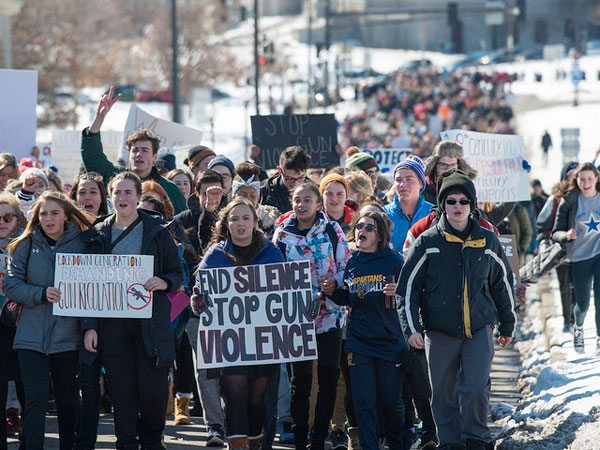
March 25, 2018, Washington Post
“Hundreds of thousands of demonstrators gathered in the nation’s capital and cities across the country Saturday to demand action against gun violence, vividly displaying the strength of the political movement led by survivors of a school massacre in Parkland, Florida,” notes Peter Jamison and his colleagues at the Washington Post. The crowd “packed at least 10 blocks of Pennsylvania Avenue,” while a New York City protest spanned twenty (narrower) blocks. All told, there were protests in an estimated 830 cities worldwide.
Many gave speeches, but perhaps none was more poignant than when Marjory Stoneman Douglas high school senior Emma Gonzalez stood silently at the mic at the end, with a timer counting off the six-minutes-and-20-seconds that it took for 17 to be shot dead in Parkland.
Also speaking in Washington were Alex King and D’Angelo McDade, writes Lisa Marie Segarra for Time Magazine. “King and McDade had met with Parkland students in Florida,” Segarra notes, “as part of an outreach to groups that have not benefited from the attention of wall-to-wall news coverage that the shooting at Marjory Stoneman Douglas had.”
“When will we as a nation understand that nonviolence is the way of a life for a courageous people? When will we as a nation understand that we are not here to fight against one another and we are here to fight for life and peace?” McDade said.
According to John Woodrow Cox and Steven Rich of the Washington Post, the Parkland massacre is the 193rd K-12 school to experience a shooting on campus during school hours since 1999. In total, Cox and Rich add, there have been an average of “10 school shootings per year since Columbine, with a low of five in 2002 and a high of 15 in 2014. Less than three months into 2018, there have been 11 shootings, already making this year among the worst on record.”
Since Columbine, more than 187,000 K-12 students have experienced a shooting during school hours, Cox and Rich add, with significant trauma resulting. A study published in Pediatrics in 2015, write Cox and Rich, found “that kids who witness an attack involving a gun or knife can be just as traumatized as children who have been shot or stabbed.”
Millions of children have participated in lockdown drills, which are now mandatory in some states. Much as “duck and cover” was a mainstay at the dawn of the nuclear age, so are lockdowns today. The result, note Cox and Rich, has been to change “the culture of education and how kids grow up….Every day, threats send classrooms into lockdowns that can frighten students, even when they turn out to be false alarms. Thousands of schools conduct active-shooter drills in which kids as young as four hide in darkened closets and bathrooms from imaginary murderers.”
Sign up for our free newsletters
Subscribe to NPQ's newsletters to have our top stories delivered directly to your inbox.
By signing up, you agree to our privacy policy and terms of use, and to receive messages from NPQ and our partners.
Writing earlier this month in New Hampshire’s Concord Monitor, high school junior Jennifer White relates that drills happen “so often that it has become automatic.”
Because we’ve grown up in a culture where mass shootings are a constant threat, even at school, we don’t think much of these drills. Yet each time we hear of another school shooting, we are reminded of their gravity.
“It’s no longer the default that going to school is going to make you feel safe,” says Bruce D. Perry, a psychiatrist and a leading national expert on childhood trauma. “Even kids who come from middle-class and upper-middle-class communities literally don’t feel safe in schools.”
“Mass shootings at predominantly white schools draw the most attention from journalists and lawmakers, but…children of color are far more likely to experience campus gun violence—nearly twice as much for [Latinx] students and three times for black students,” Cox and Rich write. All told, Cox and Rich report that “62.6 percent of the students exposed to gun violence at school since 1999 [have been] children of color.”
What happens now? In South Florida, the editors of the Sun Sentinel observe that “Cynics say Saturday’s marches were a feel-good moment that will do nothing.” But there is reason for believing, as the Sun Sentinel editors write, that perhaps this time is different. Already, Florida has passed a law that raises the minimum age to buy any firearm to 21, extends the waiting period to three days, and bans bump stocks.
In South Florida, the Sun Sentinel adds, “A more than one-mile-long line of demonstrators in West Palm Beach marched within shouting distance of Mar-a-Lago on Saturday, making sure President Trump didn’t miss the gun-control message during his weekend getaway.”
It has only been six short weeks since the Parkland shooting and much remains uncertain. But just as fears of nuclear annihilation helped motivate a lasting peace movement a half-century ago, it is conceivable that the movement against gun violence won’t be fading away any time soon.—Steve Dubb













